How to choose the best clothes dryer
Learn how to buy the best clothes dryer for your laundry. Our guide discusses the different types of clothes dryers and the features to look for when you buy a clothes dryer.
We’ve tested vented, condenser and heat pump clothes dryers to find which ones are fastest, most energy efficient and have the best features.
Different types of clothes dryers
How does a clothes dryer work? Different types of clothes dryers work in different ways and their pros and cons vary.
Vented clothes dryers

Vented clothes dryers are simple. They suck in air, heat it, and blow it through your washing. Moisture in the washing evaporates and is then blown back out. Ideally, they’ll be ducted outside.
- Cheaper to buy than condenser and heat pump clothes dryers
- Need to be vented or ducted outdoors to prevent damp walls and ceiling
- Expensive to run
Condenser clothes dryers
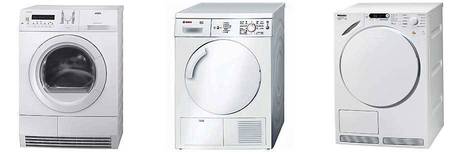
Condenser clothes dryers have a heat exchanger that removes heat and moisture from the air that’s passed through your washing. The moisture is collected (as water) in a reservoir or funnelled out a drain.
- Don't need to be vented or ducted outdoors – just crack a window
- Expensive – often double the price of vented clothes dryers
Heat pump clothes dryers
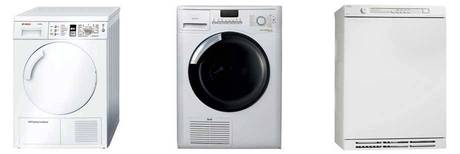
These clothes dryers use a small heat pump to heat the air that’s blown through your washing. The warm, damp air is then cooled to remove the water, which collects in a reservoir or is funnelled out a drain.
The cool air is then reheated and recycled. This closed loop system means there’s very little moisture released into the room. Heat pump clothes dryers are ideal in places where external venting isn’t possible.
- Energy efficient – cheap to run
- Don't need to be vented outdoors
- Expensive – four times the price of some vented models
Clothes dryer features
Size
Consider the different clothes dryer sizes. Larger capacity models can dry more at once, but they’re generally physically bigger too. Measure the space available in your laundry area.
Ducting
Vented clothes dryers emit a lot of moist air. A model that can be ducted outside is preferable to prevent dripping walls and mouldy ceilings.
Some clothes dryers come with ducting kits, while others have kits as an optional extra. There are also universal ducting kits available from many appliance stores.
Wall mountable or stackable
You'll save space if your clothes dryer can be mounted on the wall or stacked on top of a front-loading washing machine. Typically, vented clothes dryers are the only type that can be mounted on the wall. Stackable models are designed to pair with a washing machine of the same brand.
Drying racks
Racks are useful for drying shoes and other items not suited to tumble drying – they’re usually an optional extra. There are both internal and external types. External racks only work with non-ducted models that have an exhaust in the front door.

What about a washer-dryer?
A washer-dryer does the job of a washing machine and clothes dryer in a single appliance. Is one right for you?
Clothes dryer functions
Sensor and timer or timer only
A sensor detects when the washing is dry and automatically turns off the dryer. But some clothes dryer sensors turn off the machine before the load has fully dried. If the sensor of your clothes dryer isn’t working as well as you’d like, use the timer instead.
Sensor and timer models tend to be more expensive than timer only clothes dryers. Think about how often you'll use the sensor or whether you need it at all.
Reverse tumbling
Dryers that reverse the direction of their drum at regular intervals minimise tangling and dry your washing more evenly. Check our test results to see which models have reverse tumbling.
Settings
Some clothes dryers come with a bunch of extra settings: extra dry, very dry, cupboard dry and so on. Don't pay more for a machine with settings you won't use. Basic low and high settings will do the job.
Drying time
This varies between models and depends on the capacity of the machine and the weight of washing being dried. The quickest clothes dryers can dry a load of clothes in under 2 hours. Slower models can take an hour or more longer. Our test results show which models are quickest.
Manual restart
Dryers that automatically start tumbling again if you open and close the door mid-cycle are dangerous for young children who might climb inside the drum and shut the door behind them. All the clothes dryers we've tested need to be manually restarted.
Energy rating labels

The Energy Rating Label shows how energy-efficient a model is compared to other models of the same capacity.
More stars = more energy efficient.
The energy consumption figure is in kilowatt-hours (kWh), and you can use this figure and the cost (tariff) from your latest power bill to calculate how much a clothes dryer will cost to run. The MBIE-reported national average cost of a kWh in New Zealand is 29¢.
Lower kWh = cheaper to run.
Clothes dryer annual energy consumption in kWh is based on standards testing and assumes 52 uses a year.
You should only compare star ratings of clothes dryers with the same or similar capacities.
For information on energy ratings and how to use them, see our Energy Rating Labels explained article.
Clothes dryer life cycle costs
How much does a clothes dryer cost across its lifespan?
If your new clothes dryer costs you several thousand more to buy than another, less energy efficient model, you’ll need to make that money back through lower running costs.
That’s why we calculate life-cycle costs, which show the real cost of a clothes dryer over 10 years. Inflation and interest rates mean each dollar spent on a dryer now is worth more than a dollar saved through reduced running costs in the future. We also factor in an estimated yearly power price hike of 1%.
We plotted the average life-cycle cost over 10 years for the top-performing models in each category. You’ll need to use a heat pump clothes dryer 383 times every year to make it a better option than a condenser model, and 549 times a year to make it better than a vented clothes dryer.
A heat pump dryer will only offer true savings if you’re running it every day. This might suit large families or workplaces. But, for the typical family, a vented clothes dryer will be the cheapest option to buy and run.
If your laundry can’t be ducted or ventilated well, then a condenser clothes dryer is likely your most economical choice.
Average dryer life-cycle cost over 10 years
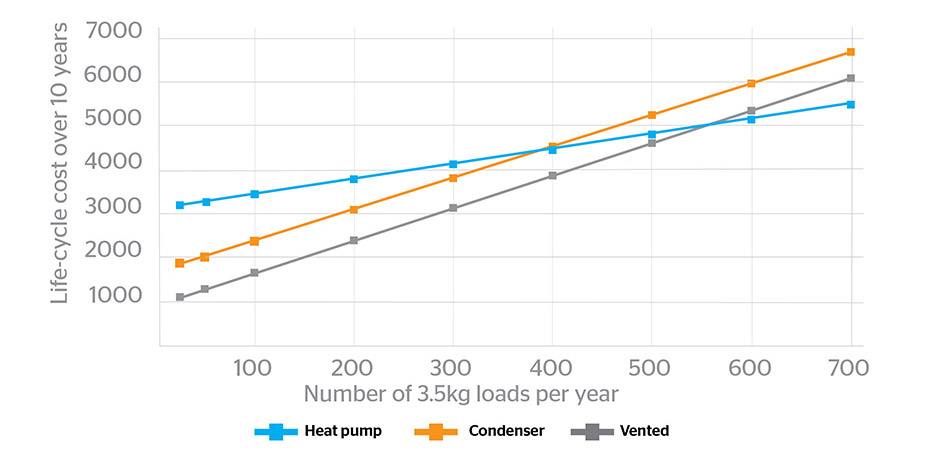
GUIDE TO THE FIGURE We’ve charted the average 10-year life-cycle costs for the models in each category which perform well enough to earn our recommended tick. The intersection of the lines is the number of loads per year required to make heat pump dryers economic with respect to condenser or vented models. Results are shown for a 3.5kg load.
Buying a secondhand clothes dryer
A clothes dryer is a basic appliance, and you can buy one cheaply secondhand. Under the Electricity Act, all electrical appliances for sale must be safe, whether they're new or secondhand, bought privately or from a dealer.
Here are some things to check when buying secondhand:
Condition: Does the clothes dryer look clean and tidy? Check the drum, door, control panel and other components for cracks, dings or excessive scratches. Does the door close properly? Do all the buttons work?
Age and usage: Ask the seller how old the dryer is and how often it’s been used. 10 years is a reasonable lifespan for a clothes dryer.
Brand and model: Check our clothes dryers test results for both current and discontinued models to see how the dryer performed in testing. Our discontinued models go back several years. If the clothes dryer was widely available when it entered the New Zealand market, there’s a good chance we’ve tested it. Also be sure to check the brand’s reliability and satisfaction ratings.
Features and settings: Check whether the clothes dryer has the features and settings you want. Look for adjustable heat settings, various drying cycles – for example, delicate, heavy-duty, timed drying and moisture sensing (auto).
Maintenance and repair history: Ask about the clothes dryer's history. Has it had regular maintenance? Have any major repairs have been done.
Price and guarantee: Compare the clothes dryer’s asking price with the prices of similar models on the market. Don’t be afraid to negotiate. A quick internet search will help you decide a fair price based on the dryer's age, condition and features.
Energy efficiency and running costs: Consider the clothes dryer’s energy efficiency rating. There’s information at Energy rating labels (above) plus a link to a calculator to work out how much a specific model will cost to run each year based on how often you’ll use it.
Test run: If possible, request a test run of the clothes dryer before purchasing it. This lets you check whether the dryer runs smoothly and heats up properly. Listen for any squeals or other unexpected noises – they can be a sign that it needs some maintenance or is nearing the end of its useable life.
Your rights if things go wrong
Bought something and want to take it back? Consumer members can contact our Consumer Advice Line for help. Our advisers will talk you through your rights.
Buying new
If a product you buy is faulty or not of acceptable quality, you don’t have to put up with it. The Consumer Guarantees Act has got you covered – you don’t need a warranty. Here's more about how you can get a refund, repair or replacement for a faulty product.
Buying used
If you’re buying from a secondhand dealer (including those listed as “in trade” on Trade Me) and discover the product is faulty, you're covered by the Consumer Guarantees Act. It should be of acceptable quality, fit for purpose and match the description. But you’re not covered by the act when buying privately. Here's more info about your rights when buying second hand goods.
We've tested 76 clothes dryers.
Find the right one for you.
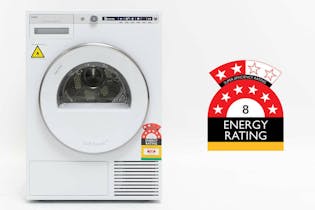
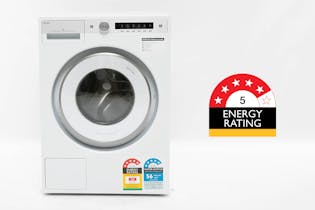
.jpg&w=315&q=75)